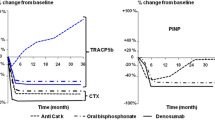Summary
Markers of types I and III collagen turnover were measured in serial blood samples in 16 patients with a Colles' fracture. The collagen markers were the carboxy-terminal extension peptide of type I procollagen (PICP) and the amino-terminal extension peptide of type III procollagen (PIIINP). Significant increases were found of PIIINP within 1 week and of PICP within 2 weeks. This sequential appearance of PIIINP and PICP was found to be in agreement with the appearance of types III and I collagen during early fracture healing as demonstrated in previous animal experimental studies. PICP had levelled off after 9 months, whereas PIIINP remained elevated. Osteocalcin, a serum marker of osteoblast activity, increased within 1 week and levelled off after 9 months. Correlations betwen the change in osteocalcin and those in PICP and PIIINP, respectively, were weak. These new biochemical markers may prove relevant as non-invasive markers of normal and pathological fracture healing in humans.
Similar content being viewed by others
References
Einhorn T, Simon G, Devlin V, Warman J, Sidhu SPS, Vigorita VJ (1990) The osteogenic response to distant skeletal injury. J Bone Joint Surg [Am] 72:1374–1378
Gay S, Viljanto J, Raekallio J, Penttinen R (1978) Collagen types in early wound healing in children. Acta Chir Scand 144:205–211
Haukipuro K, Risteli L, Kairalouma M, Risteli J (1990) Aminoterminal propeptide of type III procollagen in serum during wound healing in human beings. Surgery 107:381–387
Johansen JS, Molholm Hansen JE, Christiansen C (1987) Radioimmunoassay for bone Gla protein (BGP) in plasma. Acta Endocrinol (Copenh) 114:410–416
Lane JM, Suda M, von der Mark K, Timpl R (1986) Immunofluorescent localization of structural collagen types in endochondral fracture repair. J Orthop Res 4:318–329
Multimaki P, Aro H, Vuorio E (1987) Differential expression of fibrillar collagen genes during callus formation. Biochem Biophys Res Commun 142:536–541
Obrant KJ, Merle B, Bejui J, Delmas PD (1990) Serum bone-Gla protein after fracture. Clin Orthop 258:300–303
Page M, Hogg J, Ashhurst DE (1986) The effects of mechanical stability on the macromolecules of the connective tissue matrices produced during fracture healing. The collagens. Histochem J 18:251–265
Parfitt AM, Simon LS, Villanueva AR, Krane S (1987) Procollagen type I extension peptide as a marker of collagen biosynthesis in bone. Correlation with iliac bone formation rates and comparison with total alkaline phosphatase. J Bone Miner Res 2:427–436
Risteli L, Risteli J (1990) Non-invasive methods for detection of organ fibrosis. In: Rojkind M (ed) Focus on connective tissue in health and disease, vol 1. CRC Press, Boca Raton, Florida, pp 61–98
Sevitt S (1971) The healing of fractures in the lower end of the radius. A histological and angiographic study. J Bone Joint Surg [Br] 53:519–531
Author information
Authors and Affiliations
Rights and permissions
About this article
Cite this article
Joerring, S., Jensen, L.T., Andersen, G.R. et al. Types I and III procollagen extension peptides in serum respond to fracture in humans. Arch Orthop Trauma Surg 111, 265–267 (1992). https://doi.org/10.1007/BF00571521
Issue Date:
DOI: https://doi.org/10.1007/BF00571521




